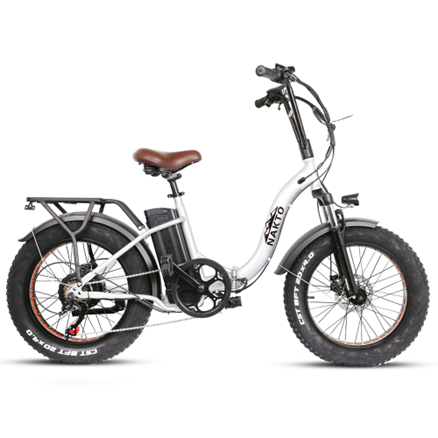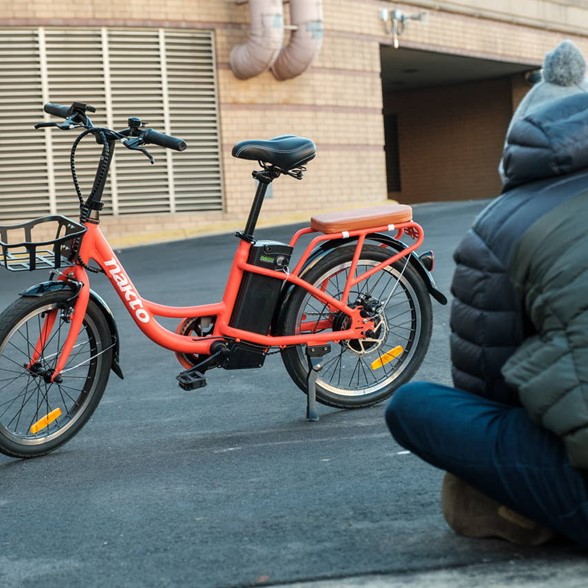As electric bicycles continue to evolve, they are increasingly seen as more than just an alternative mode of transportation; they represent a lifestyle choice that emphasizes efficiency, sustainability, and the joy of riding. This article delves into the essence of electric bicycles, unraveling their workings, varieties, and the myriad benefits they bring to the urban landscape and beyond.
In this comprehensive exploration, we will unveil the intricacies of how e-bikes work, their diverse forms, and the considerations one must take into account when embracing this eco-friendly and efficient mode of transportation. Join us in discovering the fascinating world of electric bikes, a world where innovation meets tradition, and mobility takes on a new, electrified form.

What is an Electric Bike?
Electric bikes (e-bikes) represent a significant leap in the evolution of cycling, blending traditional pedal power with modern technological advancements. An e-bike is essentially a bicycle that is equipped with an integrated electric motor, offering assistance to the rider’s pedaling effort. This innovative combination not only enhances the ease of riding but also expands the potential uses and benefits of bicycles.
E-bikes come in various styles, adapting to a wide range of cycling needs. From models designed for efficient urban commuting to those built for rugged mountain trails, e-bikes cater to diverse preferences. Whether it’s a cargo bike for transporting goods or a folding bike for compact storage and transport, there is an e-bike for virtually every scenario.
How Electric Bikes Work
Motor Placement and Its Effects
The placement of the motor in an e-bike is a key factor influencing its ride feel and performance:
- Front-Hub Motors: Similar to front-wheel-drive vehicles, they offer responsive handling in corners but may lack traction compared to rear-wheel setups.
- Rear-Hub Motors: Located at the back, these motors provide better traction and more stable handling, interacting with the bike’s gears and other rear components.
- Mid-Drive Motors: Positioned under the rider’s center of balance, these motors ensure a stable, natural riding experience and are often considered the premium choice.
The Heart of E-Bikes: The Battery Pack
The battery pack is the power source of an e-bike, determining its range and overall efficiency:
- Placement and Aesthetics: Batteries are typically placed on or inside the downtube, with more expensive models featuring internal, hidden batteries for a sleek look.
- Types and Capacity: Modern e-bikes predominantly use lithium-ion batteries, known for their light weight and efficiency. Battery capacity, measured in Amp-hours (Ah) or Watt-hours (Wh), varies across models, affecting the bike’s range.
- Charging and Durability: Charging times can range from a few hours to overnight, depending on the battery’s capacity and quality. Lithium-ion batteries generally offer a substantial number of charge cycles, ensuring longevity and consistent performance.
Controller and Pedal-Assist Mechanisms
The controller acts as the mediator between the battery and the motor, dictating the motor’s speed and power usage. It plays a crucial role in determining the e-bike’s range and the nature of motor assistance. Pedal-assist sensors, either cadence or torque types, are integral in regulating the level of assistance provided based on the rider’s pedaling.
By understanding these core components, riders can better appreciate the mechanics behind e-bikes and make informed choices tailored to their specific cycling needs and preferences.
Advantages of Electric Bikes
Electric bikes offer a unique blend of advantages that set them apart from traditional bicycles, with one of the most significant being their enhanced performance, particularly in terms of speed and efficiency.
1. Assisted Speed and Range
E-bikes come with an integrated electric motor, which significantly augments the rider’s pedaling power. This assistance allows riders to achieve higher speeds with less effort compared to a regular bike. The speed boost is particularly beneficial for commuting, enabling riders to cover longer distances more quickly and with less fatigue. Additionally, e-bikes are ideal for tackling challenging terrains like steep hills, where the extra power can make a substantial difference.
2. Speed Limits and Design Influence
The typical speed range of e-bikes is influenced by motor power and design. Most e-bikes offer motor-powered assistance up to speeds of around 20 to 28 miles per hour, varying by design and regional regulations. This speed range makes e-bikes a highly efficient mode of transport, striking a balance between the speed of motor vehicles and the accessibility and health benefits of traditional bicycles.
3. Classification and Speed Capabilities
E-bikes are categorized into three main classes, each with distinct speed capabilities:
Class 1: These e-bikes provide motor assistance only when the rider is pedaling, and the assistance typically cuts off at 20 mph. Ideal for urban commuting and casual cycling.
Class 2: Similar to Class 1 in terms of pedal-assist, but also include a throttle, allowing motor assistance even without pedaling, up to 20 mph. Suitable for riders who may need a break from pedaling.
Class 3: These offer pedal assistance like Class 1 but with a higher cutoff speed of 28 mph, catering to those who require a faster commute.
4. Versatility in Applications
The varied classifications of e-bikes cater to different riding needs and preferences, from leisurely rides around the city to more demanding commutes. This versatility extends the appeal of e-bikes to a wide range of users, from fitness enthusiasts to those seeking a more efficient and environmentally friendly mode of transport.

The Value Proposition of Electric Bikes
Practicality Across Various Domains
Commuting
Electric bikes shine as an efficient mode of urban transport. They allow commuters to bypass traffic congestion, offer a cost-effective alternative to public transport or driving, and reduce commuting times. E-bikes make commuting accessible for a wider range of people, thanks to the reduced physical strain compared to traditional bikes.
Fitness and Health
While e-bikes provide pedal assistance, they still offer a significant physical workout, allowing riders to control the level of exertion. They are excellent for gradually building fitness levels and can be particularly beneficial for those recovering from injuries or with limited physical abilities.
Leisure and Recreation
For leisure riders, e-bikes open up new possibilities. They allow for longer rides with less fatigue, making them perfect for exploring new terrains or enjoying longer cycling trips without the physical strain associated with traditional biking.
Environmental Impact
Reduced Carbon Footprint
E-bikes represent a sustainable transportation option. They emit no direct pollutants, contributing significantly to reduced urban air pollution and lower carbon emissions compared to motor vehicles.
Energy Efficiency
Electric bikes are highly energy-efficient, requiring far less energy per mile than cars or motorcycles. This efficiency, combined with the growing trend towards renewable energy sources for electricity, further enhances their environmental credentials.
Legal Considerations
Registration Requirements. The need for registering an e-bike varies based on local and national laws. In some regions, e-bikes are treated similarly to bicycles, requiring no registration, while in others, particularly where e-bikes are capable of higher speeds, registration may be necessary.
Licensing for Riders. The requirement for a driver’s license to operate an e-bike also depends on local regulations and the class of the e-bike. Generally, lower-powered e-bikes (like Class 1 and 2) do not require a driver’s license, but higher-powered models (like Class 3) might, especially in certain jurisdictions.
Conclusion
Electric bikes present a compelling blend of efficiency, accessibility, and environmental friendliness. They offer practical solutions for commuting, fitness, and leisure, all while contributing to a greener and more sustainable future. Their varied designs cater to a wide spectrum of users, ensuring there is an e-bike for every need.
Ultimately, the choice of an e-bike should be guided by individual needs and preferences, aligned with local legal requirements. Whether seeking a bike for efficient urban commuting, recreational activities, or as a stepping stone to improved fitness, e-bikes offer a versatile and adaptable solution. As the world of transportation evolves, electric bikes stand out as a key player in shaping a more sustainable, efficient, and enjoyable future of mobility.












